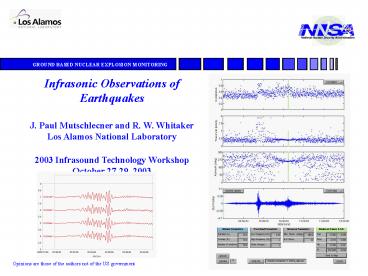Infrasound workshop 897 - PowerPoint PPT Presentation
1 / 23
Title:
Infrasound workshop 897
Description:
Understand infrasound signals with respect to earthquake characteristics ... Provide estimate for earthquake infrasound signals. Discuss future directions ... – PowerPoint PPT presentation
Number of Views:86
Avg rating:3.0/5.0
Title: Infrasound workshop 897
1
Infrasonic Observations of Earthquakes J. Paul
Mutschlecner and R. W. Whitaker Los Alamos
National Laboratory 2003 Infrasound Technology
Workshop October 27-29, 2003 JaJolla, California
Opinions are those of the authors not of the US
government
2
Overview
- Review infrasound signals from earthquakes
- Understand infrasound signals with respect to
earthquake characteristics - Provide estimate for earthquake infrasound
signals - Discuss future directions - modeling and
earthquake parameterization
3
Infrasound Earthquake Data Set
- Number of earthquake events 30
- Number of signals 47
- Number of stations recording 4
- 1983 - 2002
- 13 multi-station detections
- Analysis is ongoing
4
Local Distribution Map
5
0.5-3.0 Hz data
2/22/02 M 5.7 32.38 N 115.35W Channel data and
Infra_Tool Az Dev 1.7o
6
Data Set Characteristics
7
Data Set Characteristics
8
Data Set Characteristics
ltDurgt 14.0 min s 9.4
ltfgt 0.84 Hz s 0.49
9
Duration (in min) vs Mb
Examination of several other parameters Shows
no well defined trends Possible indication of
range dependence
10
Long Signal Duration for EQ
- Source (EQ) duration
- But most Earthquakes have motion over only a few
seconds to a minute (aftershocks may contribute
for larger Mb - Atmospheric propagation
- Usual competition between pulse stretching and
dissipation - HE signals of similar size have shorter
durations - Source extension by seismic surface waves
- Relation to magnitude supports this concept
- Known cases of extended sources (eg Coalinga,
1983, and Northridge, 1994) - But for longest durations source must be 100s km
in diameter and durations are not always
symmetric about epicenter signal
11
Fmax vs Reported Depth
12
Amplitude Scaling for Distance and Stratospheric
Wind
- Where
- Vd - wind component directed, source to array
- Vz - zonal component of stratospheric (50 km)
wind - Vm - meridional component of stratospheric wind
- q- azimuth to source
- Distance and wind parameters are empirically
derived - and b 1.45 and k 0.018
See An Empirical Study of Infrasound
Propagation, 1999, J. Paul Mutschlecner, Rodney
W. Whitaker and Lawrence H. Auer, LA-13620-MS,
Los Alamos National Lboratory
13
Scaled Amplitude vs Mb(all events)
- R2 0.591
- 0.419
- b 0.454
14
Peak Vertical Velocity (at 1 km) and ML40 Events
- R2 0.595
- 0.230
- b 0.558
From Empirical Analysis of Near-Source Ground
Motion, 1980, A. F. Shakal and D. L. Bernreuter,
NUREG/CR-2095 (UCRL-53028)
15
Sources of Uncertainty
16
Statistical Simulations
denote random variations
17
Results of Statistical Simulations
50 simulations Monte Carlo approach
18
Summary
- Relations determined
- Log(Asc) vs Mb
- Duration vs Mb
- Frequency vs depth
- Uncertainty sources identified and match to
observations - Better earthquake source parameterization needed
- Source modeling being established
19
Back Ups
20
Sources of Uncertainty
21
Frequency of Max Energy vs Mb
22
Close-in Ground Motion Velocities for 10/15/79
EQ, Imperial Valley (6.6)
From Empirical Analysis of Near-Source Ground
Motion, 1980, A. F. Shakal and D. L. Bernreuter,
NUREG/CR-2095 (UCRL-53028)
23
Scaled Amplitude for Best Wind Data
- R2 0.691
- 0.405
- b 0.556

